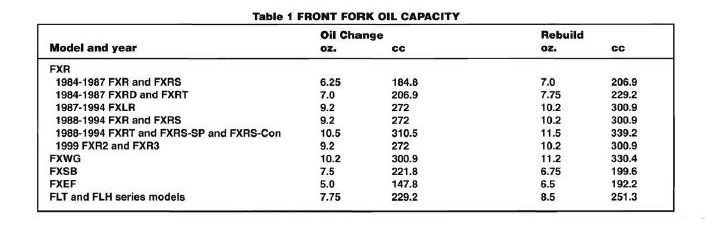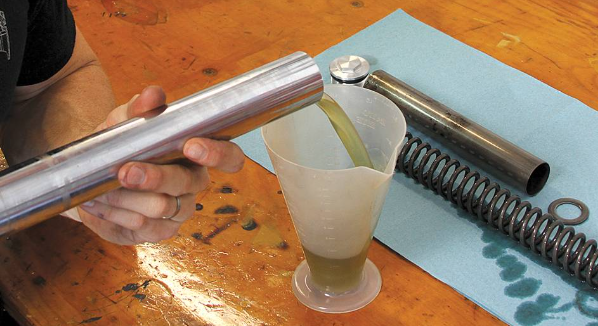
Harley or other motorbike riders must remember that the fork oil is critical to maintenance and needs regular changing. Not knowing how much forklift your bike requires can lead to damage, mainly if you use too little or too much. The Harley Fork Oil Capacity Chart is an invaluable tool in this regard. It provides a definitive list of oil capacities for different Harley Davidson models.
The chart contains information on dry and wet oil requirements for each model’s forks so that users can purchase the correct amount without assistance. In addition, helpful tips and advice on the frequency of changes are also included in the Harley Fork Oil Capacity Chart to ensure optimal performance from the motorcycle’s forks.
By referring to the Harley Fork Oil Capacity Chart when making changes, Harley Davidson owners can maintain their bikes in top condition while avoiding unnecessary wear and tear on their motorcycles’ parts due to incorrect lubrication levels. With such an easy solution, keeping your bike running smoothly should no longer be a problem!
Understanding the Significance of the Harley Fork Oil Capacity Chart:
Regularly changing your fork oil is an essential part of owning a motorcycle. It helps keep the forks lubricated and functioning correctly and protects them from wear and tear while riding in dusty or muddy conditions. For riders who put many miles on their bike or frequently ride, it’s recommended that they check their fork oil levels more often than those who only ride occasionally.
When it comes time to change your fork oil, there are some steps you should take to ensure it gets done correctly. The first step is draining the fluid from the tubes before adding new juice. When adding new oil, you want to ensure that all old liquid is gone so that no contaminants are left in the system. Once this has been done, fill up each tube with fresh oil and secure the caps tightly so no air can get inside them once they’re put back together again.
Finally, after everything has been secured, start up your Harley for a few minutes and turn off the engine immediately afterward to allow any air bubbles trapped in the tubes to escape before using your bike regularly. These simple steps will go a long way toward keeping your forks functioning optimally for years!
Harley Fork Oil Capacity Chart

| Model Name | Model Year | Wet (Oz.) | Dry (Oz.) |
|---|---|---|---|
| Sportster | 1972-83 | 5.0 | 6.0 |
| FX/FXE | 1973-83 | 5.0 | 6.0 |
| Sportster | Till 1972 | 5.5 | 6.5 |
| FX/FXE | 1972 | 5.5 | 6.5 |
| Sportster | 1984-87 | 5.4 | 6.5 |
| FXR/FXRS | 1985-86 | 6.0 | 7.0 |
| FL/FLH | 1948-77 | 6.5 | 7.0 |
| FLT | 1980-97 | 7.75 | 8.5 |
| FL/FLH | 1977-84 | 7.75 | 8.5 |
| FLT | 1998-2001 | 8.7 | 9.7 |
| Sportster XL 883 Hugger | Till 1991 | 9.0 | 10.2 |
| Sportster | 1988-2003 | 9.0 | 10.2 |
| FXR/FXRS | 1991-94 | 9.0 | 10.2 |
| FXWG/FXST | 1980-84 | 9.0 | 10.2 |
| Dyna/Low Rider | 1991-2005 | 9.2 | 10.2 |
| FXSTD | 2007 | 10.5 | 11.6 |
| Sportster | 2004-08 | 10.5 | 11.6 |
| Sportster XL 883 Hugger | 1992-99 | 10.7 | 12.1 |
| FLHR | 2002-09 | 10.1 | 11.1 |
| Dyna Wide Glide | 1991-2005 | 10.2 | 11.2 |
| FXWG/FXST | 1985-2006 | 10.2 | 11.2 |
| FXST | 2007-09 | 11.5 | 12.5 |
| FLST | 1986-2006 | 11.5 | 12.5 |
| FLST | 2007-09 | 12.4 | 13.4 |
Explanation of the Chart
Fork oil capacity can be a tricky and complex topic to understand. It is essential to pay close attention when determining the correct amount of fork well for each application. This chart has two types of measurements (wet and dry), which require different quantities of division well during damp and dry conditions. Wet refers to the complete drain out of the plug, while Dry requires taking the forks apart and cleaning them from inside to outside, with 0.5-1.0 oz more than wet forks being necessary in this circumstance.
The Harley Davidson company provides information regarding their 49mm Fork Oil Capacity, which is more than 24 fl ounces, as well as their 41mm Fork Oil Capacity at 11.8 ounces; both are popular queries on web searches today due to their importance in understanding this subject matter correctly. Despite some correlation between its size and capacity, it is not linear, thus making proper research even more essential to get accurate results for your particular situation.
You must consider all factors influencing your specific requirement before applying any quantity of fork well to avoid any unforeseen issues further down the line. In addition, consulting with an expert or referring back to reliable sources such as manufacturer’s websites could prove beneficial if you are still deciding or overwhelmed about the next steps.
Here are some helpful tips for changing the oil in your Harley’s fork

Maintaining the forklift in a motorcycle is essential to keep it running safely and efficiently. The performance of the fork oil remains consistent regardless of temperature, terrain, or riding style. However, over time, the oil will start to degrade and need to be changed for optimal performance.
Changing fork oil should be relatively simple and can be done by anyone with basic knowledge and tools. Draining old oil from the forks before cleaning them out is essential for proper replacement. One should replace any existing fork oils with an identical type and weight for best results.
If you need help with adequately changing the fork oil on a motorcycle, enlisting help from a professional is beneficial in promptly getting it done correctly. Generally speaking, Harley-Davidson should have their oils replaced between 5000-6000 miles; however, experts suggest going up even further up 10000-15000 miles, depending on usage habits.
What should you search for in a capacity chart for Harley Forks?
Understanding fork oil charts is essential for the proper maintenance of a motorcycle. To ensure that the graph is valuable and reliable, it should have these qualities:
- Readability – It should be easily understandable and contain no confusing symbols or jargon.
- Reliability – Data must be accurate and from reputable sources like Harley.
- Relevance– Be sure to include the latest information to stay current with trends.
What is the recommended frequency for changing fork oil?
The frequency of fork oil changes for Harley Davidson motorcycles is not linear. Experts suggest replacing the fork oil every 3000 to 5000 miles, depending on riding frequency and terrain.
As a motorcycle is ridden, suspension compressing and rebounding cause extreme heat, which the fork oil helps absorb to maintain performance without any drops. Regularly replacing this fluid ensures optimal functionality of your vehicle’s suspension system for a smooth ride.
Final Thoughts on Harley Fork Oil Capacity Chart
Maintaining a motorcycle by changing the fork oil regularly can be essential to preserving its performance. When performing this task, it is necessary to consider the correct quantity of oil and viscosity and promptly address any potential leaks. Tools like the Harley Fork Oil Capacity Chart can simplify this task by providing the accurate amount of oil needed for various Harley models.
Expert advice should be sought if any issues arise during this process to ensure optimal results. Alongside professional advice, the Harley Fork Oil Capacity Chart can be a reliable reference for maintenance tasks.
Following these steps and utilizing resources such as the Harley Fork Oil Capacity Chart can help extend the life and effectiveness of your forks while allowing for your bike’s safe operation. Taking the initiative on simple maintenance tasks such as changing the fork oil can save time and money in the long run.
FAQs About Harley Fork Oil Capacity Chart
How much fork lubricant is required for a Harley-Davidson motorcycle?
One should introduce 11.2 ounces (330 ml) of Type E Fork Oil specific to Harley-Davidson into the fork chamber. It’s advised to pump the fork chamber until a certain resistance is sensed, followed by a few additional pumps to expel any trapped air.
What’s the oil capacity of a Harley’s fork chamber?
When the 49mm fork chamber is fully stretched out, infusing it with slightly above 24 fl. oz. of fork lubricant is recommended.
Does a denser fork lubricant offer any advantages?
The rate at which the lubricant travels through the shock valves is determined by its viscosity, commonly perceived as density. For those who favor rapid rebounds, a thinner oil is ideal. Conversely, a denser fat is the way for those who appreciate more gradual rebounds.
What’s the standard viscosity of fork lubricant used in Harley motorcycles?
Typically, Harley employs a lubricant that matches the viscosity of 8 to 10-weight oil in their default shocks. However, experts like Jan and Sparky often suggest using 30-weight oil. Their rationale is that it offers a more gradual damping effect, ensuring that after encountering a bump, the forks revert to their initial position in a more controlled manner.
